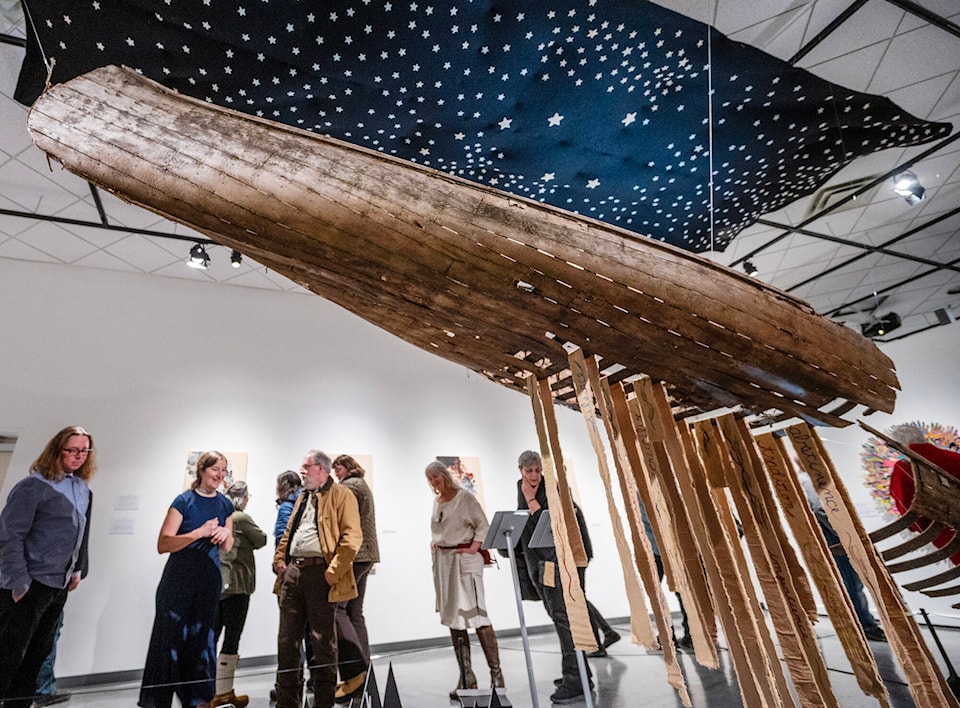It’s fitting that Marie-Hélène Comeau is talking about her new group exhibition, La chasse-galerie or The Flying Canoe, the day before she’s set to fly home to Quebec.
The show, on at the Yukon Arts Centre (YAC) until February, is based on a popular French story about Coureur de Bois in a remote camp during the holidays. Missing their families, they make a deal with the devil to fly home for 24 hours.
“The notion of long distance, of being away from the place you’re from? In the Yukon, there’s a good part of the population who were born and raised elsewhere and decided to make Yukon our home,” says Comeau over the phone.
Comeau herself has lived here for more than 30 years. She considers it home. Still, especially during the holidays, she says, there can be a pull to go to another home.
Comeau says she and her fellow artists, Virginie Hamel, Cécile Girard and Françoise La Roche, came up with the idea a few years ago. In 2021, there was a group show at YAC called Dark Alice. It explored the tale of Alice in Wonderland. Roche, she says, thought it would be fun to conceive of a similar type of show, and connected with a number of French artists.
What was a story, they wondered, that was common to the French community? They landed on The Flying Canoe, written in the late 19th century by Honoré Beaugrand.
“It’s well-known, that legend, among all the French communities across the country,” she says.
It’s less well-known, in her experience, among English-speaking Canadians, though she says the point of the story resonates more widely than in just French and English communities.
“Thinking about the dark and wanting to connect with family at this time of year, I think it feels pretty universal,” says Mary Bradshaw, director of visual arts at YAC.
Certain aspects of the show look at it through the lens of new immigrants who have arrived in the territory in recent years.
“Those who weren’t born here, those who ultimately are not from here, from the Yukon, but are living in this space.”
As part of her work for the show, Comeau interviewed people from Quebec, Israel and the Northwest Territories. She asked them each to speak, in their mother tongue, about an object they’d brought North with them from home.
She also had 40 people from different backgrounds read a portion of The Flying Canoe in their own language.
During her research, Comeau says she found that, though the story originated in France, there are versions of it all over the world. There’s an Acadian version. There’s a different version in Ontario near the Great Lakes. There’s even one in Ireland.
“I guess anywhere there’s water and canoes, there’s a version there,” she says.
Because of that, she had 40 different Yukoners from different places read a section of the story in their own language. That recording is also part of the show.
“When I approached my English participants then, none of them knew the story, so it’s fun; I had time to talk about it with them,” she says. “And even people who knew about it, the Francophones, it was interesting to hear their stories […] part of my practice, I work with people, and I have to say that I think that’s my favourite part of when I’m creating something. Meeting people and listening to their stories.”
There are headphones in the gallery where visitors can listen to participants read the story in both French and English, but audio components like these are just one part of the show.
It also includes a massive old canoe, coming apart as it lands above a miniature version of the Yukon, complete with tiny models of The Palace Grand in Dawson and the Old Firehall in Whitehorse. There are acrylic paintings in soft, cool shades illustrating the story. There are textile pieces. There are large-scale photographs from Comeau, who doesn’t often show photography in the Yukon.
“I really feel like all of them kind of pushed themselves in terms of materials,” says Bradshaw. “Like Virginie’s collage pieces? I always think of collage as quite limited by size and these are really kind of exciting to see collage on this kind of scale, and to see how bold and graphic they are.”
The work is on display in the main gallery at YAC until Feb. 16, 2024.
There is an artist talk in French at 11 a.m. on Jan. 6, 2024 and a second talk in English at 1 p.m. on the same day.
Contact Amy Kenny at amy.kenny@yukon-news.com
